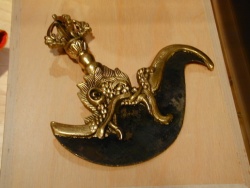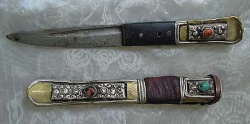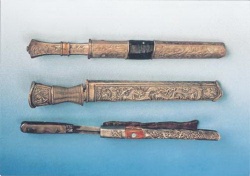Knife Culture of the Tibetan Race
EDITOR'S NOTE: Knives are indispensable to the Tibetan race in daily life. All Tibetans, male and female, carry knives. Indeed, knives have become a kind of decoration loved by boys and girls. Sheaths are also made to command high appreciation and value.
According to the Concise History of the Bon Religion, the Tibetans learned to make bows and arrows when the place was ruled by the first ruler-Yaksha;
When the place was under the rule of Radegoryador, the second ruler, the locals were good at making axes and knives;
When the place was under the rule of Norsanyirangchami, the third ruler, the locals were able to make rope traps and spears; When the place was under the rule of Magyiala, the fourth ruler, the locals could make daggers and other weapons;
When the place was under the rule of Zhamgyia Mogyiakegyi, the locals could weave and use rope traps; When Demon the 6th Zhamgyia ruled the place, the locals could jump and throw stones in games;
When the 7th of the nine Masang brothers ruled the place, the locals were able to make arrow bags, sharp weapons and shields;
During the reign of the 8th, 9th and 10th rulers, the locals were good at making pottery, stone, wooden, bone and iron tools, and had mastered weaving.
From these we see that the areas inhabited by the Tibetans in ancient times saw the birth of blacksmiths long before the period of the 1st Tubo King Nyitri Tsampo.
For example, when the 7th Tubo King Zhigung Tsampo was killed by one of his ministers, his body was contained in a copper coffin.
Variety Of Knives
According to the Historical Records of the Hans and the Tibetans, Tubo was famous for two kinds of knives: Gus Knives and Gyirab Knives.
Gus Knives
Gus knives appeared during the period of Tubo King Zhigung Tsampo.
According to Historical Records of the Hans and the Tibetans, Gus knives were made by nine brothers with small eyes in an environmentally fierce place called Sidor.
The eldest made a knife sharp enough to cut a rope ladder leading up to the heaven. His eight brothers all made knives with sharp blades as well. One of the Gus knives was the Guda knife, made by the legendary master of the nine brothers together with his offspring.
Gyirab Knives
Gyirab knives were made legendary by Mitotago in a forest known as Gyiyulhozha. These knives were sharp enough to cut down nine trees in one stroke.
The knives I have seen include:
stone knives,
sickles, scissors,
shaving knives,
small knives,
short waist knives,
long waist knives,
nail cutting knives,
butter knives,
chopping knives,
swords,
pencil sharpeners,
daggers,
bosom knives,
boot knives,
sleeve knives,
wisdom knives,
botching knives,
battle knives,
jade knives,
gold knives,
silver knives,
copper knives,
wooden knives,
white handle knives,
scalping knives,
dissecting knives,
celestial burial knives,
women's knives,
men's knives,
Bhutan knives,
Gorga knives and
Dege knives.
How To Make Knives
All Tibetans know the sayings: "Flexible as tools used by blacksmiths," and "Hammers, pliers and bellows are indispensable for blacksmiths." Other tools used by blacksmiths include files, awls, molds and welders.
Believe it or not, charcoal is also indispensable to them. The charcoal mentioned here includes dried wood charcoal, wet wood charcoal and kiln-oriented charcoal.
When forged iron or steel pieces are dipped in cold water, they tend to crack. Only those dipped in buttered tea mixed with oil and butter become soft.
When the pieces are to be used to make pencil sharpeners and other tools with sharp blades, they are coated with greasy sheep wool, the blood of antelopes and Tibetan fruit.
When they are to be used for swords and knives, they are coated with salt and butter. After being dried in the sunlight, they are re-coated with the blood of antelopes.
When dried again, they are coated with a mixture of medicinal soda ash, boron, sugar, blood from deceased humans, antelope blood, animal horn paste, dirt and salt. Then, they are re-forged and dipped into snow water. Knives cast in this way are sharp enough to cut iron as if it were mud.
Roles Of Tibetan Knives
Everyone knows what role knives play in daily life. In Tibet, however, knives have many roles: l Tools for daily life. Given natural conditions unique to Tibet, Tibetans eat meat, butter and zanba (roasted highland barley).
To eat meat, they need knives. In some places, knives serve as plows and the locals still rely on the slash-and-burn method. l Weapons. In 1904, when the British invaded Tibet, Tibetan soldiers fought with primitive rifles and long-handle waist knives.
l Adornments. Tibetan knives are adorned with handles made of bull horns, antelope horns, wood or metal.
Knife sheaths are made of animal hides, bull horns, metal or wood and are adorned with the "Eight auspicious patterns" in gold, silver, copper and iron wire, swastikas, the auspicious pattern of dragon and phoenix, or are inlaid with corals, agates, peals and jade.
Lord to Tibetan Knives
Before Gus and Gyirab knives were produced, King Gesar, the longest epic in the world, already had segments praising Tibetan knives. For example, the Battle Between the Hor and Ling States, part of the epic, lauds the knives in this way:
Don't you recognize this treasure knife in my hand? It was cast in the auspicious state of the Han area. Nine brother blacksmiths, Cast it with smelted iron when stars hung bright in the sky.
Called "Sharp Stars," Such knives were forged out of iron and copper pieces, Which were heated and dipped in the cold blood of crocodiles. Where the Han people live, These knives are called "Demon Suppressers."
When they are put into rivers and lakes, It is called "Turning the Tide." When they are used by servants, They are called "100 Pine Trees Choppers."
When they are used by maids, They are called "1,000 Cakes Makers." When they are brought to the Ling State, They are respectably mentioned as "Yasgarchon."
Each is inlaid with four gold nails, Resembling twinkling stars in the dark night sky. Adornments on the knife handle are like snow-covered mountain peaks,
And the tassel adorning the knife handle is like a hoop used to tame fierce cows. The knife's hand guard impresses people like the weak conquering the strong.
The knife's sheath has patterns showing shining stars. The knife's sheath top looks like the Yellow River winding its way around a snowy mountain.
The knife's sheath hoops are like pendulums dangling on the bosoms of girls. The front of the knife sheath is like the sun shining over the East Mountain.
The back of the knife sheath is like six tribes meeting for peace talks. The knife ridge is like heavy snow over mountain valleys.
The knife blade resembles a crescent moon. The knife's top is like a flame licking the blue sky. A treasure knife like this that sends out fire and wind, Can be used to defeat the fiercest enemy.
Origin of Tibetan Knives
In the face of a fierce natural environment with wild animals, the ancestors of the Tibetan race learned to make stone weapons, and later added blades. Many stone chips and stone knives were excavated from the ancient ruins in Qamdo and Lhasa.
Origin Of Knives
One segment of the Concise History of the Bon Religion recorded the gradually increased use of knives in Tibet.
Tibetan knives even found their way into historical records, including the Concise History of the Bon Religion: Yaksha reigned at night in the beginning, In an area named Sangyu Gyainman Then with bows, arrows and other weapons.
When ruled by Radegoryador later, The place was called Doryukarurongge, Where axes and knives appeared. When ruled by Norsanyirangchami,
The place was renamed Sengbonapogeyu, Where fetters and cannons appeared. When the Magyiala ruled the place as the fourth ruler, Daggers had already appeared in Gungtang.
When Mogyiakegyi ruled the place, There appeared chains and other weapons. When Demon the 6th Zhamgyia ruled the place, Thrown stones were used as weapons. When the 7th of the nine Masang brothers ruled the place, The place was renamed Bokanangcho, And swords and shields appeared.


